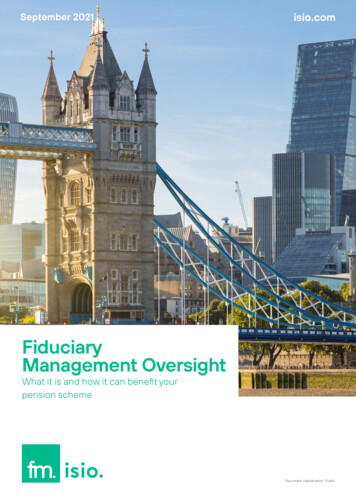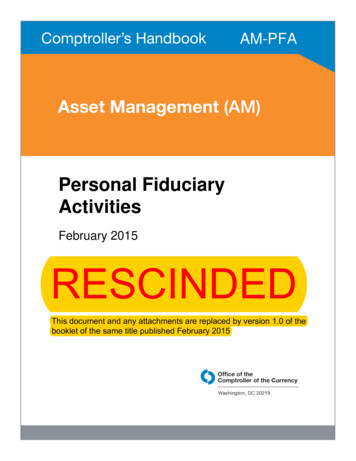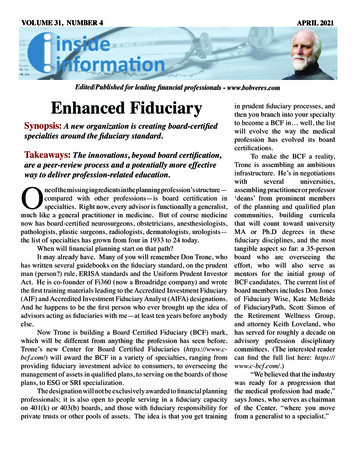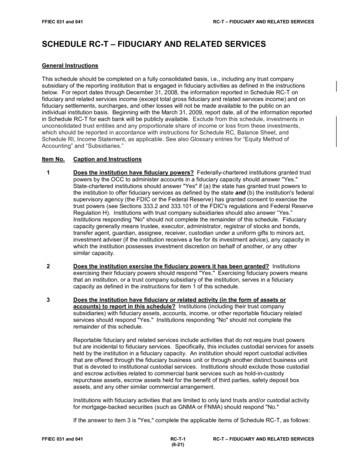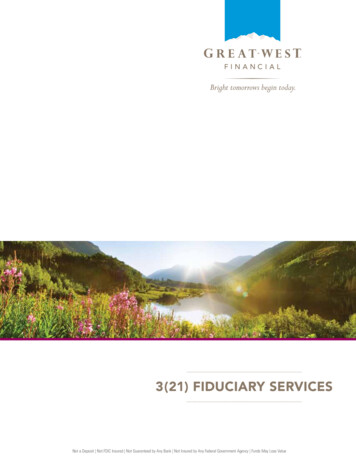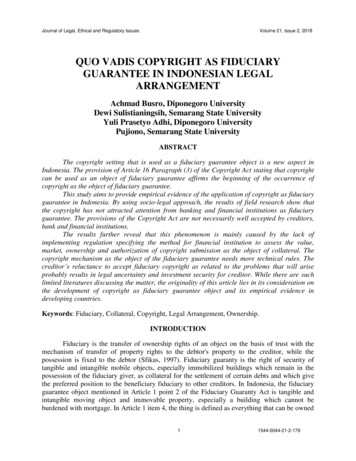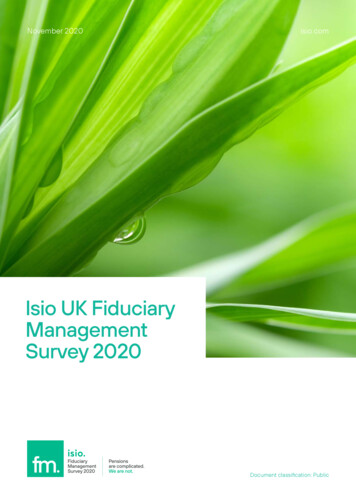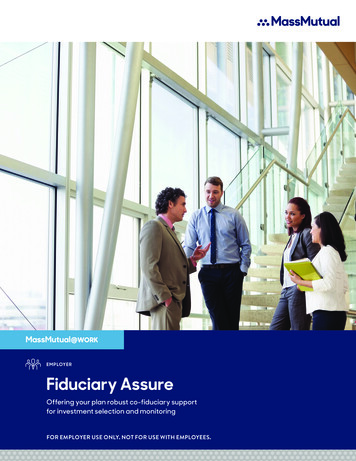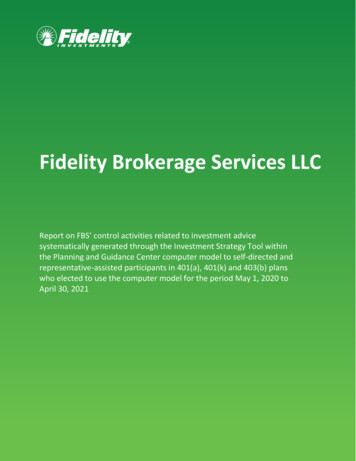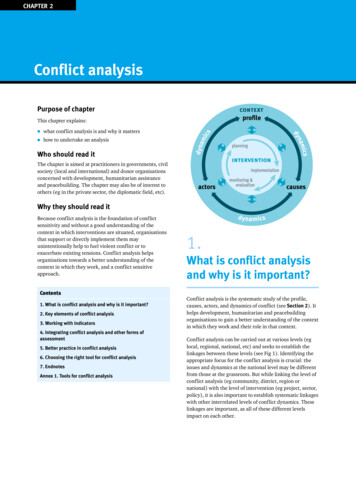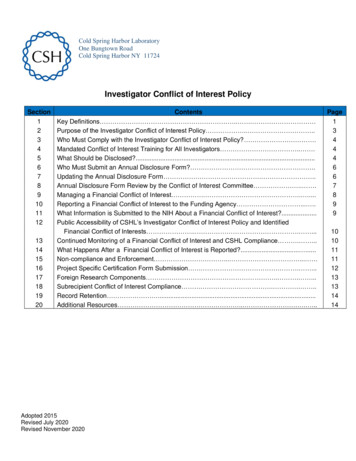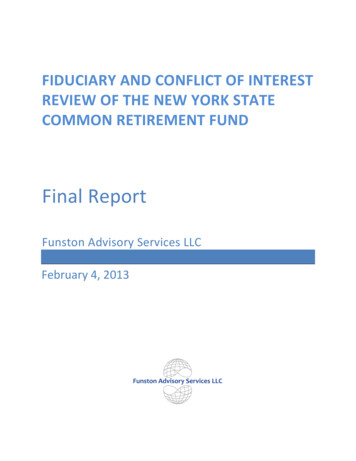
Transcription
FIDUCIARY AND CONFLICT OF INTERESTREVIEW OF THE NEW YORK STATECOMMON RETIREMENT FUNDFinal ReportFunston Advisory Services LLCFebruary 4, 2013
This page intentionally left blank.2Funston Advisory Services LLC
This page intentionally left blank.4Funston Advisory Services LLC
New York State Common Retirement FundFiduciary and Conflict of Interest ReviewTable of ContentsExecutive Summary . 7Background . 141. FIDUCIARY RESPONSIBILITIES AND FRAMEWORK FOR THE OPERATIONS AND DECISIONMAKING PROCESSES OF THE FUND . 251.A.Overall Fiduciary Compliance Conclusion . 261.B.-G. Investment Related Policies, Procedures and Practices. 262.3.4.ETHICAL, PROFESSIONAL, AND CONFLICT OF INTEREST STANDARDS . 312.A.Committees . 322.B.Employee Training . 502.C.Investment Managers, Consultants and Advisors Conflicts of Interest . 532.D.Placement Agents or Intermediaries . 562.E.Process to Investigate Complaints . 57OPERATIONAL TRANSPARENCY. 593.A.1Publication of Policies and Procedures . 603.A.2Level of Disclosure in the CAFR . 643.A.3Third Party Contractual Requirements . 663.A.4Expense Recording and Transparency . 67EFFICIENCY AND EFFECTIVENESS OF MANAGEMENT . 714.A.Investment-Related Operations . 724.B.Use of External Managers and Consultants . 804.C.Investment Accounting, Compliance, and Performance and Fund Analytics . 1184.D.Due Diligence Procedures . 127Appendix A - Official Compilation of Codes, Rules and Regulations of The State of New York, Title11. Insurance Department . 136Appendix B - Comptroller’s Compliance with the Official Compilation of Codes, Rules andRegulations of The State of New York . 146Appendix C - Fiduciary and Conflict of Interest Review Tasks . 154Appendix D - Glossary of Acronyms Used (in alphabetical order) . 160Funston Advisory Services LLC5
This page intentionally left blank.6Funston Advisory Services LLC
Executive SummaryPurpose of the ReviewEvery investment organization attempts to achieve return goals within its risk parameters. Itmust make a host of decisions about its organizational focus and deployment of resources(both assets and people). Decisions about which asset classes are appropriate, where activemanagement may prove effective, what services to “build vs. buy” and where it makes sense totake more or less risk are just a few examples. Such decision-making is made more challengingin the case of most public sector investment organizations by limitations and constraints.In many instances, pension fiduciaries must operate without full “prudent investor” discretionbecause of legislative, regulatory and other externally imposed limitations. Likewise, fiduciariesmay be required to engage in particular activities. Staffing and compensation may be subject toexternal approvals and significantly limited. In short, fiduciaries often have full fiduciaryresponsibility but less than full fiduciary authority. The Common Retirement Fund (CRF) is suchan organization.Nonetheless, working within the defined constraints and mandates, the fiduciary must stilladdress the same investment considerations as if they had no resource or other constraints. Asignificant portion of this fiduciary review involved assessing fiduciary decision-making andexecution in light of the particular structure and constraints set for the CRF.The purpose of a fiduciary review is to obtain reasonable (but not absolute) independentreassurance from third parties that fiduciaries are fulfilling their responsibilities and are incompliance with applicable laws, regulations and policies. Our findings are presented in thatcontext. The Executive Summary which follows describes the overall conclusions regarding eachtask we were asked to undertake. We have also identified several opportunities forimprovement which cut across each of the individual tasks and sub-tasks.These opportunities for improvement are summarized at the end of this section. Detaileddescriptions of each task and sub-task, the related findings and observations, conclusions, andopportunities for improvement for the CRF’s consideration are provided in the body of thereport.Funston Advisory Services LLC7
Scope of the Fiduciary ReviewFollowing a competitive Request for Proposal process, Funston Advisory Services LLC (FAS) wasselected to conduct the required fiduciary and conflict of interest review of the New York StateCommon Retirement Fund (the “Fund” or “CRF”). The review was to cover the investmentrelated operations of the Fund as constituted under and regulated by the law in effect duringthe covered period; it was not to cover the administrative operations of the New York State &Local Retirement System. The review was to take into consideration all investment-relatedconstitutional, statutory, and regulatory requirements as they are currently prescribed and notto evaluate those requirements or consider recommendations for their modification. Thecovered period is defined as the three-year period ending March 31, 2012.In this context, FAS was asked to compare the Fund’s investment-related policies, procedures,and practices with common and leading practices among selected enterprises of like characterand with like aims (e.g. state, provincial and international public pension funds and stateinvestment boards, etc.). In addition, FAS was asked to suggest, where appropriate, options forimprovement to the CRF’s investment-related policies, procedures, and practices to bring themin line with prevailing and/or leading practices. At a minimum, we were asked to determinewhether policies, procedures, and processes are in place to assure that the conduct of thebusiness of the Fund is consistent with the following principles, which are contained in theDepartment of Financial Services regulations (see Appendix A - Official Compilation of Codes,Rules and Regulations of The State of New York, Title 11. Insurance Department):A. the Comptroller fulfills his fiduciary responsibility to act for the sole benefit of theSystem’s members, retirees, and beneficiaries and maintains a strong framework for thegovernance (i.e., the operations and decision making) of the Fund;B. the Comptroller ensures the highest ethical, professional, and conflict of intereststandards are employed in managing the Fund;C. the Fund maintains a high level of operational transparency; and,D. the Comptroller ensures the Fund is managed in an efficient, effective manner.8Funston Advisory Services LLC
Summary ConclusionsBased on the information made available to Funston Advisory Services LLC (FAS) in the form ofdocuments and interviews, we can provide independent and reasonable (but not absolute)assurance that:1. Fiduciary Responsibilities and Framework for theOperations and Decision Making Processes of the FundThe Comptroller is fulfilling his fiduciary responsibility to act for the sole benefit of the System’smembers, retirees, and beneficiaries. The Fund has a strong and effective framework foroperations and decision making processes. Investment-related policies and practices are robustand appropriate. The CRF is in compliance with its policies.2. Ethical, Professional, and Conflict of Interest StandardsThe Comptroller manages the Fund in accordance with the applicable ethical, professional, andconflict of interest standards. The CRF’s committees are functioning according to law.Committee reviews of Investment Policy have been done as required . The CRF’s fiduciary andethics training for committees seems exemplary. Information provided to the committees isdetailed and comprehensive. Employee training appears consistent with prevailing practice.Policies and practices concerning conflicts of interest for investment managers, consultants andadvisors are consistent with prevailing practice. Compliance certifications are completed in atimely manner in most cases. The CRF’s policy on the use of placement agents orintermediaries is an appropriate exercise of the Comptroller's fiduciary responsibilities whichhas been prudently implemented and operates as an effective risk management tool. The CRF’sprocess to investigate complaints is consistent with legal requirements and prevailing practice.3. Operational TransparencyThe Fund maintains a high level of operational transparency. The CRF is a leader in mostcategories of data and policy disclosure. The type and detail of data contained in the CRF’sComprehensive Annual Financial Report (CAFR) is consistent with prevailing practices. The CRFhas also received a certificate of excellence in financial reporting issued by the GovernmentFinance Officers Association (GFOA). Third party contractual reports are appropriatelyaccessible. Expense recording and transparency comply with regulations and provide a leadingpractice for peers in regard to the level of detail disclosed.Funston Advisory Services LLC9
4. Efficiency and Effectiveness of ManagementInvestment-related operations are well-run. The Investment Advisory Committee and the RealEstate Advisory Committee are used effectively. The level of support provided to the CRF andinvestment staff by attorneys, both internal and external, are appropriate. The number ofexternal managers and the sizes of the accounts or funds under management, in comparisonwith common and leading practices of diversification, appear to be suitable. Other costsassociated with external asset management, including custody, securities lending, andtransaction fees appear to be appropriate.The Investment Accounting section of the Accounting Bureau is adequately staffed, effectivelymanaged and in compliance. Investment accounting and reporting are in conformance withGenerally Accepted Accounting Principles (GAAP). The Accounting Bureau also appears to bewell prepared for upcoming changes resulting from Governmental Accounting Standards Board(GASB) Pronouncements 67 and 68 relating to accounting and financial reporting for pensionplans. The Compliance Officer is appropriately independent and there seem to be effectivesystems to monitor compliance. Investment Performance and Fund Analytics appearappropriately independent.The CRF’s due diligence procedures with respect to the selection, monitoring, and terminationof external managers are consistent with common and leading practices and appear to beeffective.A complete compliance checklist is contained in Appendix B - Comptroller’s Compliance with theOfficial Compilation of Codes, Rules and Regulations of The State of New York.Summary Opportunities for ImprovementContextIn general, the Fund has a consistently high quality investment staff despite constraints onheadcount and compensation. However, the CRF is very thinly staffed relative to its size andcomplexity. This was evident from interviews and discussions with staff, consultants andmanagers and was confirmed by the FAS Leading Practices Survey.In addition, the CRF has gone through a very turbulent period. First, it had to respond to the2007 “pay to play” scandal. Then the 2008-2009 financial meltdowns quickly ensued. Inresponse, the CRF underwent a series of regulatory and leadership changes which resulted ininterim positions and vacancies in the CIO and other key positions. The effects of these crises,combined with the resultant changes in leadership, and lack of investment staff in asset classes10Funston Advisory Services LLC
targeted for growth, have slowed the CRF’s progress towards achieving its 2009 target assetallocation plan.The Fund does need to address several basic challenges to ensure that it is managed in anefficient and effective manner in the future. The Fund has relatively low staffing levels inseveral asset classes, a tendency to leave vacancies unfilled for many months andunderdeveloped / underutilized human resources and information technology support. Whilethese issues have not prevented the Fund from managing the existing investment programeffectively, it has slowed development and implementation of new strategies. The Fundrecognizes it needs a long-term resources plan that aligns with its long-term investmentstrategy.In 2007, the Comptroller established a special Pension Task Force to assess the adequacy ofsafeguards and controls and make recommendations for improvement. The Task Forcesubmitted its report in 2009 and the CRF has since implemented most of its recommendations.These recommendations included, for example, establishing a Risk and Reporting Departmentand a Compliance Department. However, those two functions have not yet been givenadequate resources to fulfill their duties optimally.1. Improve utilization of HR and IT support functionsMaintaining a strong investment operation with the staff and infrastructure to effectivelymanage risk and respond to investment opportunities requires running not only theinvestments of the Fund, but also its associated HR and IT functions. The Fund has had a strongfocus on managing the CRF’s investments effectively, but the CRF’s employee recruitment anddevelopment processes, related human resource (HR) programs and information technology(IT) infrastructure appear, as noted earlier, to be underdeveloped or underutilized. Thisincludes recruiting and on-boarding of staff, providing ongoing training, succession planning,and building and maintaining an integrated, highly-functional supporting informationtechnology infrastructure.2. Re-align and optimize resourcesChronic understaffing and limitations on investment staff compensation levels have shapedseveral aspects of the Fund’s investment operations and approach to resource deployment asinvestment strategies have become more sophisticated and complex.First, as mentioned earlier, the growth of Fund investment staff has not kept pace with thegrowth in assets under management and investment complexity, nor has the Fund hadadequate resources to implement the 2009 asset allocation plan in a timely manner. As aFunston Advisory Services LLC11
result, the Fund is not fully invested in the markets in the manner intended. We recognizethere were interim targets (due to the challenge of moving the allocations of a fund the size ofthe CRF) but the CRF is still behind in meeting those targets.Second, the level of resources has significantly affected the decisions as to whether to managevarious investments internally or through external managers. The Fund has lacked theresources to efficiently gain exposure to various asset classes and management styles and, as aresult, has had to tailor how it gains that exposure to fit available resources. This resulted inhigher investment management costs, which reduce net returns to the Fund.Third, the CRF also makes more extensive use of consultants than most of its peers. At leastpart of that cost seems to be a substitution of external resources for internal ones, at a highercost. In evaluating the deployment of Pension Investment and Cash Management (PICM)resources, Fund leadership should first consider the desired mix of asset class, activemanagement and passive management, internal management and external management andthen consider the resources available. Some adjustments may improve effectiveness.Finally, as mentioned earlier, the Risk and Reporting and Compliance functions appear to beunderstaffed. Although there have not been major financial or compliance incidents over thepast few years, it would be prudent to ensure that these two functions are staffed at a levelthat supports enhanced investment risk management and compliance capabilities.3. Improve organizational effectivenessThe Fund staff is very dedicated and capable and has performed admirably under challengingcircumstances over the past few years. However, our review identified several potential areasfor improving the effectiveness and efficiency of how the Fund operates on a day-to-day basis.It may be worthwhile to assess the current structure of decision-making delegations to identifydecisions which could be made more appropriately and efficiently at a different level. A leadingpractice identified among the peer funds is the delegation of certain investment functions tothe CIO, for example, asset rebalancing and exposure management. This should result indelegations being structured to reflect the degree of relevant expertise and value added ateach level, with appropriate reporting and monitoring of how authority is exercised.Administrative delegations might also be examined.The format of documentation requirements for investment decisions appears to be lessconsistent across asset classes than we have seen at other funds. PICM's current efforts torationalize and streamline the process should help to reduce this diversity and result in moreeffective and efficient document management and compliance review processes across asset12Funston Advisory Services LLC
classes and locations. This should be seen as an important initiative for risk management andcompliance monitoring.In addition, Fund policies have not been updated on a consistent basis, nor are they wellcoordinated with each other. However, the Fund has established a General Investment Policyframework, and this should provide a platform for the future integration and updating all of itspolicies. Ensuring that all policies are updated on a regular, consistent and coordinated basiscould help avoid compliance questions arising due to inconsistent policies.Finally, the PICM staff is physically located in three sites, one in Albany and two in New YorkCity, adding to coordination issues. Several efforts now underway, including a new documentmanagement system and an enlarged attendance at the Internal Investment Committeemeetings, should help. Ultimately, consolidation of the two New York City offices is an optionthat ought to be considered.The main body of the reportFor a fund the size of the CRF, operating as it does in the complex markets in which it invests,challenges likely will continue to increase. Evolution of the Fund and adaptation to the growingcomplexities of the financial markets will be required, especially in an environment whereachieving assumed returns will be difficult.The report that follows is an attempt to address in some detail the positive foundation in place,improvements that may be indicated and preparation for the growing challenges of thefinancial markets. As noted at the beginning of this Executive Summary, a host of decisions arerequired in meeting fiduciary standards. We have attempted to provide in-depth analysis andconsiderations to help with those decisions, within the existing CRF structure.Funston Advisory Services LLC13
BackgroundThe New York State Common Retirement FundThe New York State Common Retirement Fund (“CRF” or the “Fund”) is the third largest statepublic pension trust in the United States and among the largest pools of institutional capitalglobally. The CRF holds assets in trust for over one million public sector members, retirees, andbeneficiaries of the New York State and Local Employees’ Retirement System and the New YorkState and Local Police and Fire Retirement System (collectively, the “System”), which includeover 3,000 participating employers. As sole trustee of the CRF, the Comptroller is responsiblefor the investment, oversight, and management of the assets of the Fund to provide retirementand other benefits for current and future members, retirees and beneficiaries of the System. Asof March 31, 2012, the Fund had invested assets of 150.6 billion. For fiscal yearend 2011-2012,the funded ratio for the System was 90%.Mission StatementThe objective of the Fund is to manage its assets on behalf of the System’s members, retireesand beneficiaries in a manner that will meet actuarial return, minimize volatility, and protectand enhance long term value.StructureThe CRF is constituted as a trust that holds and invests the assets of the Fund for the exclusivebenefit of the members, retirees and beneficiaries of the System. The Comptroller mustoperate the CRF in a manner consistent with the fiduciary responsibility required of him as soletrustee of the Fund. With staff support from the Executive Deputy Comptroller for the System,the Chief Investment Officer/ Deputy Comptroller for the Division of Pension Investment andCash Management (“PICM”) and the Counsel to the Comptroller and their professional staffs,and the CRF’s outside counsel, consultants, and advisory committees, the Comptrollerdetermines policies and manages the investment operations of the Fund. PICM staff managesthe assets of the Fund on a day‐to‐day basis.Because PICM functions as a division within the Office of the State Comptroller (OSC) it issubject to the internal controls, reporting and management processes of the overallorganization. Staff of the Division of Retirement Services, which administers the benefitoperations of the System, and staff of Division of PICM, which is responsible for investing theassets of the Fund, also report to the Executive Deputy Comptroller for the System.14Funston Advisory Services LLC
Fund AssetsThe following chart shows target allocations of asset classes within the Fund. New Yorkimposes statutory restrictions on the type and amount of assets in which the Fund can investwhich may affect the allocations (see Table 1 below):TABLE 1Target Asset AllocationsAsset ClassDomestic EquityInternational EquityPrivate EquityReal EstateAbsolute ReturnOpportunistic PortfolioReal AssetBonds, Cash and MortgagesInflation Indexed BondsFund TotalLong Term 0%8.0%100.0%Actual Allocationas of 00%RegulationThe Common Retirement Fund, similar to other New York public pension plans, is subject toState statutory limitations on investments.1 This “legal list” system specifies broad categories ofpermissible investments for the Fund and is in contrast to the unlimited “prudent investor”standard that now applies to many other state public pension plans, as well as to corporatepension plans under ERISA. For example, the following categories of investments are prescribedby statute2:1Article9 of the New York Retirement and Social Security Law (“RSSL”)The Comptroller, as the Trustee of the CRF and the administrator of the System, is permitted to invest theassets of the CRF in specific types of investments enumerated in several sections of the RSSL, includingSections 13, 313, and 177 – 179, and by incorporation under Section 177(1), those securities that the trusteeof a savings bank could invest in pursuant to Section 235 of the State Banking Law. These statutory sectionsalso contain limitations on the amount of specific investments the CRF may hold. In addition to the foregoing,Section 177(9) of the RSSL provides that up to 25% of the Fund’s assets may be invested in investments thatdo not qualify or are otherwise not permitted under the RSSL (the “Basket Clause”). The Fund utilizes theinvestment flexibility created by the Basket Clause to invest in real estate, private equity, international equity,and absolute return strategies investments (the CRF’s investments pursuant to the legal list and the BasketClause shall be collectively referred to herein as “Investments”).2Funston Advisory Services LLC15
investment grade, U.S. dollar denominated bonds;up to 70 percent of the CRF in equities (of which 10 percent can be allocated tointernational equities);up to 10 percent of the CRF in real estate; and,a “basket clause” in State law allows up to 25 percent of the CRF’s assets to be investedoutside constraints of the legal list, provided those investments are consistent with theprudent investor standard. Investments such as private equity, hedge funds, andinternational equities above the cap specified above, as well as international bonds, allfall within the “basket clause."In addition to regular external and internal audits, the CRF is subject to external oversight byNew York State Department of Financial Services (formerly the Department of Insurance),which is authorized by State law to promulgate regulations applicable to all public pensionplans in New York State. Working collaboratively with the State Comptroller, the Departmentpromulgated new regulations (which include additional oversight activities) applicable to theFund, effective in November 2008. A key purpose of this review is to determine the extent towhich the CRF has implemented the regulations. This is described further under “Scope ofFiduciary Review.”Investment processes are documented in a series of policies and procedures. These areprepared by staff and approved by the Comptroller and the Deputy Comptroller for PICM.Under current policies and procedures, significant investment decisions must be approved byprofessional investment staff, an independent consultant, the relevant CRF committee, legalcounsel, the Chief Investment Officer and the Comptroller. Adherence is tested by internalcompliance staff, internal and external audit and audits by the State Department of FinancialServices.Background to the requirement to conduct a Fiduciary reviewIn December of 2006, former State Comptroller Alan Hevesi pleaded guilty to a felony involvingmisuse of State resources, including having a state employee working as a driver for his wife,and resigned his office. In February of 2007, the current Comptroller, Thomas P. DiNapoli, waselected by the State Legislature to serve the remainder of the term through December 31,2010. 3 Beginning in 2007, the New York State Attorney General, the Securities and ExchangeCommission and the Albany County District Attorney conducted investigations into newallegations that investment firms had made improper payments to politically connected3Comptroller DiNapoli was elected to a full, four-year term in November, 2010.16Funston Advisory Services LLC
intermediaries in exchange for investments from the New York State Common Retirement Fundduring Hevesi’s administration.These investigations of “pay to play” practices and subsequent prosecutions extended over aperiod in excess of three years and culminated in eight guilty pleas from individuals, includingAlan Hevesi and David Loglisci, former Chief Investment Officer of the Fund. FormerComptroller Hevesi and Hank Morris, a longtime political consultant to Mr. Hevesi, receivedprison sentences for their misconduct. In addition, the Attorney General’s Office recoveredover 100 million for the Fund from various investment managers and intermediaries.Upon taking office, the current Comptroller and his staff assisted in the investigation, providingthousands of documents and electronic records and significant staff resources includingextensive interviews. At the same time, the Comptroller undertook a number of initiatives torestore integrity to the Office of the State Comptroller, imposing a variety of ethics reforms toaddress the manner in which the Common Retirement Fund is managed; to address potentialconflicts of interest in the payment of placement agent fees by investment managers to thirdparties in connection with CRF investments; and, to improve the investment process byadopting policies and procedures to strengthen internal controls and to increase oversight andtransparency.These actions included: Initially, establishing and implementing a system to review and publicly report the use ofa placement agent paid by investment managers in connection with CRF investments,and later, banning them altogether;Prohibiting investme
Investment accounting and reporting are in conformance with Generally Accepted Accounting Principles (GAAP). The Accounting Bureau also appears to be well prepared for upcoming changes resulting from Governmental Accounting Standards Board (GASB) Pronouncements 67 and 68 relating to accounting and financial reporting for pension plans.
